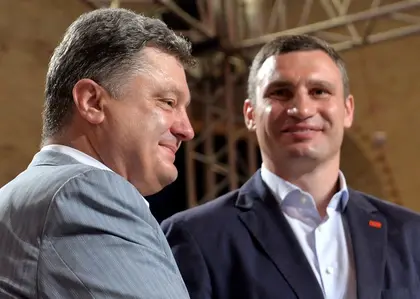Ukraine experienced a similar situation in 2007, when a parliament elected in the wake of the 2005 Orange Revolution was dissolved.
Although the next parliament may be more reflective of society, the key question is whether it will be able to overcome the populist tendency to promise more spending than recession-plagued Ukraine can deliver. It is also uncertain whether the new parliament will have a critical mass of lawmakers able to push through changes to liberalize the economy, strengthen democratic institutions, cut government deficits and curb corruption, among other reforms, especially if they prove unpopular with voters.
JOIN US ON TELEGRAM
Follow our coverage of the war on the @Kyivpost_official.
The next Rada is only likely to have 415 members or less out of the usual 450 because there will be no elections in the annexed Crimea and some parts of Donetsk and Luhansk oblasts that are not controlled by the Ukrainian authorities.

Half of Ukraine’s parliament is elected though party lists, which will be the same across the country. Another 213 deputies are scheduled be elected through single-member districts, where the set of candidates will be unique for each constituency. The number will still go down because the Central Election Commission is unlikely to be able to organize elections in some parts of Donbas.
The composition of the next Rada will be very different from the current one, according to Olga Aivazovska, head of Ukraine’s biggest election watchdog Opora. She says at least 40 percent of the current lawmakers will be replaced. Sociologist Iryna Bekeshkina, head of the Democratic Initiatives Foundation, puts that figure at 60 percent.
The new Rada is likely to be more pro-European than the current one, while pro-Russian forces are expected to be an insignificant minority. “There will be no split regarding Russia,” Bekeshkina said.
Viktoria Siumar, a candidate on Prime Minister Arseniy Yatseniuk’s People’s Front list and ex-deputy secretary of the National Security and Defense Council, said that at least 80 percent of the new parliament members are going to be pro-European.
Another difference is that it will include journalists, representatives of civil society and commanders of volunteer battalions who have appeared on the lists of most major parties who have a chance to cross the 5 percent threshold. “The parliament is ceasing to be a closed club for insiders,” Siumar said. “There will be no decision-making behind closed doors.”
She also said that the Rada was expected to include reform-minded EuroMaidan activists. But there will be plenty of people who have been a part of the system for a long time and have benefited from it.
A consultant of an opposition party who spoke on the condition of anonymity because he is not authorized to speak to the media, said that up to 180-200 deputies in the next parliament will be recycled lawmakers of Party of Regions, or close to former President Viktor Yanukovych’s supporters such as Rinat Akhmetov and Serhiy Lyovochkin.
He said many of those deputies will be elected through single-member districts, while others have been planted into the party lists that have a chance to cross the parliamentary threshold, including the Poroshenko Bloc. The consultant even suggested that there might be an anti-Poroshenko coalition formed in the Rada next spring. Under the current constitution, the coalition gets to appoint most of the Cabinet in Ukraine.
Bekeshkina also sees the dangers of unsustainable populist polices and general instability.
“The next parliament will be much more radical and unstable and may be dissolved in a year,” political analyst Taras Berezovets said, adding that he doubted it would be able to carry out reforms.
Siumar said that major political crises were possible next year, and another snap election would be a good way out. If the next Rada manages to carry out constitutional and economic reforms, a snap election will also be a good way to reboot the political system, she added.
According to a poll conducted by the Democratic Initiatives Foundation on Sept. 12-21, 26.9 of those who are planning to vote will choose the Poroshenko Bloc, while Oleh Lyashko’s populist Radical Party was the runner-up with 6.2 percent and former Prime Minister Yulia Tymoshenko’s Batkivshchyna got 5.5 percent.
Former Defense Minister Anatoliy Hrytsenko’s Civil Position, the People’s Front and the nationalist Svoboda party are expected to get 4.6 percent, 3.9 percent and 3.3 percent, respectively. Outsiders included the Communist Party with 3 percent, Kyiv Mayor Vitaly Klitshchko’s UDAR with 2.8 percent, former Deputy Prime Minister Sergiy Tigipko’s Strong Ukraine with 2.8 percent and Lviv Mayor Andriy Sadovy’s Samopomich with 1.7 percent.
UDAR will participate in the election as part of the Poroshenko Bloc.
Berezovets said that the Poroshenko Bloc was likely to control close to half of the next parliament.
The Poroshenko Bloc, formerly known as Solidarity, was set up in 2001 but had led a shadowy existence until early 2014, when Poroshenko launched his bid for the presidency. His party list has hoovered up activists and journalists, as well as other political hangers-on.
This party is expected to become the backbone of the next Cabinet, which is also likely to include representatives of other pro-European parties. The next Cabinet might theoretically include a mix of representatives of the Poroshenko Bloc, the People’s Front, the Civil Position, which is headed by former Defense Minister Anatoliy Hrytsenko, and Oleh Lyashko’s Radical Party, Siumar said. If the People’s Front gets enough votes, Yatsenyuk might remain prime minister, she added.
Hrytsenko, leader of the Civil Position, told the Kyiv Post that the party would consider participating in the government coalition if the next Cabinet shared its ideas.
Kyiv Post staff writer Oleg Sukhov can be reached at [email protected].
You can also highlight the text and press Ctrl + Enter




